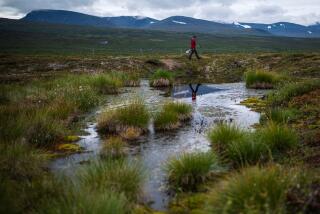Volcano-induced die-off paved way for dinosaurs, study suggests
More than 200 million years ago, toothy crocodile-like creatures stalked a hot, dry mega-continent while squid-like mollusks with spiral shells drifted in the surrounding ocean. Then, in what passes for an instant in geologic time, they vanished — making way for the age of the dinosaurs.
How some 50% of terrestrial vertebrates and an even larger share of marine life died off in the late Triassic period has become more clear from new research published online Thursday in the journal Science.
The work lends greater validity to the theory that a massive volcanic event tore apart that continent and blanketed Earth’s atmosphere, turning the ocean acidic and snuffing out animals that could not adapt. That geologic event, which created the Atlantic Ocean, ushered in the biggest biological shift in the planet’s history.
“It set the stage for the dinosaurs to take over, biologically,” said Paul Olsen, a geologist at Columbia University’s Lamont-Doherty Earth Observatory, who did much of the field work on which the study is based.
Pushed by the nascent Atlantic, the ruptured pieces of Pangea drifted off and further split, carrying the evidence of ecological collapse to such distant locales as Morocco, Nova Scotia and New Jersey.
Matching the fossil record in sedimentary rock with the dense basalt formed by the volcanic eruptions proved difficult, even with sophisticated tools of the 21st century. It was difficult to say whether the eruptions happened before the mass extinction.
Olsen and others, however, hacked rare zircon crystals from the basalt formations and measured traces of lead and uranium for radiometric dating tests. The results narrowed the margin of error in dating the lava to a mere 15,000 to 22,000 years — stunning precision for geochronology.
The crystals were not easy to find, or to process, although Olsen mined one from a rocky outcrop at a New Jersey highway exit near his home.
Zirconium is a stubborn element that did not readily mix with the magma but formed large crystals of zirconium silicate — best known as the mineral zircon — that incorporated uranium in their lattices. Over time, that uranium decayed to lead. Measuring the ratio of uranium to lead enabled the scientists to date the rock with great precision.
“People have long suspected that flood basalts had caused the extinction event, but the problem was there was an uncertainty of 1 [million] to 3 million years,” said geologist Terrence Blackburn of the Carnegie Institution in Washington, the study’s lead author.
The more refined ages put “a sharper tip on that pencil,” said Paul Renne, a geochronologist at UC Berkeley who has done similar research but wasn’t involved in the new study. “It says all this stuff is true and here’s when it happened.”
The mass extinction occurred 201.56 million years ago, around the age of one of the basalt rock formations dated by the team, according to the researchers.
There were several pulses that spewed millions of cubic miles of lava, each separated by tens of thousands of years, Blackburn said. The first of them was probably big enough to cause the extinction, and subsequent ones occurred as life began to recover and dinosaurs exploited the territory left empty by the mass die-off.
For now, the data “strongly imply a causal relationship” between the eruption that broke up Pangea and the extinction that occurred around the same time, the researchers concluded. How the die-off happened “remains unclear,” they wrote, though they offer support for a massive climatic shift brought on by volcanoes.
Renne praised the researchers for their “very clever” use of zircon. But he noted that focusing on these relatively obscure pockets could introduce some bias. “If you’re only looking at these lavas, you may not be sampling a representative suite,” he said.
If there is a lesson for modern climate change, it is mixed. Doubling the amount of carbon in the atmosphere in 20,000 years or less — which scientists say occurred in the late Triassic — would be catastrophic to life on Earth, Olsen said. Industrialization is probably adding carbon to the atmosphere at a far more rapid pace.
“You’re basically turning the ocean into soda pop,” he said. “That’s the problem we’re facing now — turning the ocean acidic. Here we are, doing it in less time.”
It may be too early to draw a parallel with modern times, however. Carbon in the atmosphere was far higher to begin with during the Triassic, Olsen noted.
“It would be a mistake to assume we’re headed into a mass extinction,” he said.







